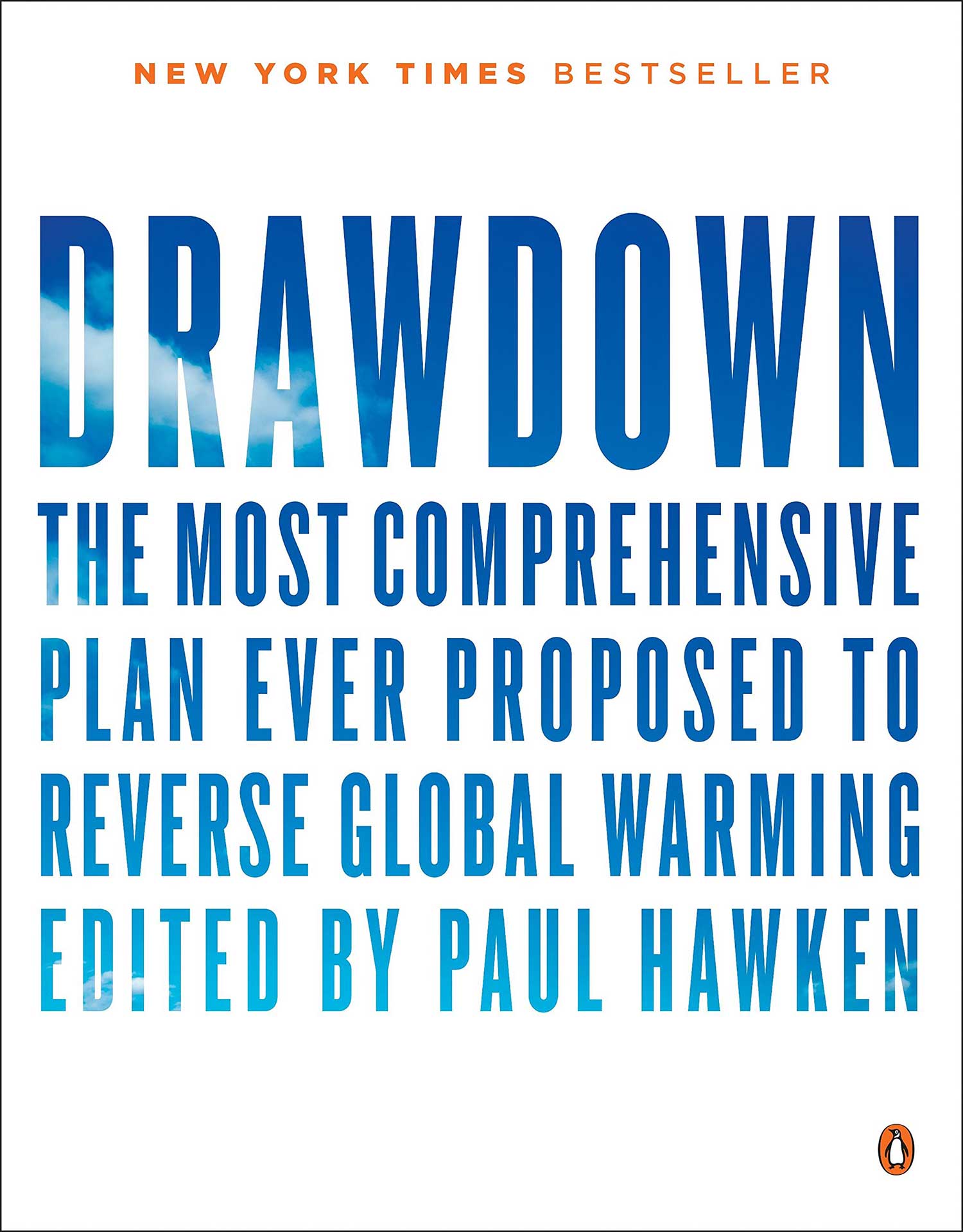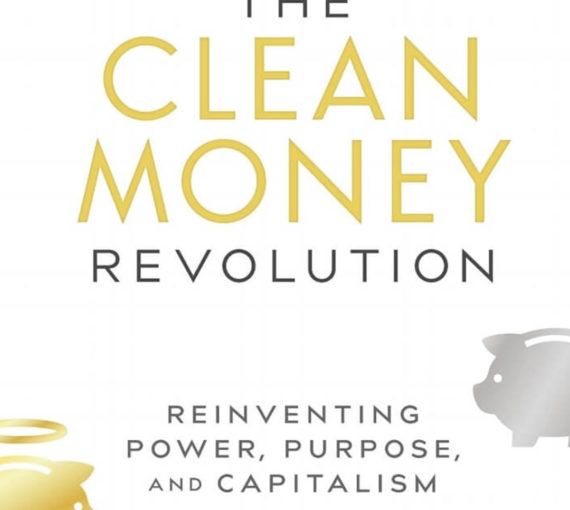 Drawdown: The Most Comprehensive Plan Ever Proposed to Reverse Global Warming is a book that addresses the climate crisis at its very roots. Editor Paul Hawken, who made his name with such environmental classics as Natural Capitalism and The Ecology of Commerce, says reducing or even halting new greenhouse gas emissions is not enough. At this moment in history we also need to remove from the atmosphere – and safely store – carbon that already exists. Drawdown’s foreword states the thesis succinctly: “We know we can’t avoid the cataclysmic impacts of global warming by only focusing on achieving zero net carbon emissions; we must also rapidly re-sequester carbon.”
Drawdown: The Most Comprehensive Plan Ever Proposed to Reverse Global Warming is a book that addresses the climate crisis at its very roots. Editor Paul Hawken, who made his name with such environmental classics as Natural Capitalism and The Ecology of Commerce, says reducing or even halting new greenhouse gas emissions is not enough. At this moment in history we also need to remove from the atmosphere – and safely store – carbon that already exists. Drawdown’s foreword states the thesis succinctly: “We know we can’t avoid the cataclysmic impacts of global warming by only focusing on achieving zero net carbon emissions; we must also rapidly re-sequester carbon.”
Toward this end, the book outlines 100 climate solutions – 80 of which we can embark upon right away and 20 of which are “coming attractions” that will be available soon.
Drawdown has a wonderful embedded optimism. Hawken sees global warming “not as an inevitability but as an invitation to build, innovate, and effect change, a pathway that awakens creativity, compassion, and genius.” Mindful of the dangers, he nevertheless finds great opportunities for human advancement – moral and intellectual. This is not a book merely about carbon. The climate solutions generate good jobs, save trillions of dollars, empower women and create beauty.
We know we can’t avoid the cataclysmic impacts of global warming by only focusing on achieving zero net carbon emissions; we must also rapidly re-sequester carbon.
Building a movement
If the goal is movement-building, Hawken’s approach is smart. If he spoke only about GHG-reduction his readership would be narrow. It has the potential to be much larger because he emphasizes the solutions’ ancillary benefits. Even if one cares nothing about climate, one can see the value, for example, of renewable energy’s contribution to employment.
Some of the solutions are well-known. One of the most important – the second most effective overall – is expansion of wind turbines. The book models a plausible scenario in which onshore wind goes from providing about three percent of global electricity today to 21.6 percent in 2050. The result: a staggering 84.6 gigatons of C02 are avoided because of reduced reliance on fossil fuels. Drawdown quotes Bloomberg, and suggests that, by 2030, wind will be the cheapest of all electricity sources. No wonder that in Denmark, for instance, wind provides over 40 percent of the nation’s power. This is renewable energy going mainstream.
Windmills also have a lesser-known benefit, one especially important in a warming world: they use “98 to 99 percent less water than fossil fuel-generated electricity.”
Another obvious solution is ramping up solar power, both utility-scale “farms” and smaller rooftop arrays. The carbon reduction is immense and – because the “fuel” is free – the savings in operational costs are enormous. The book estimates that, between 2020 and 2050, solar farms alone could bring five trillion (USD) in net savings compared to other forms of generation. A beautiful symbol of hope is the plan to build a massive one-gigawatt solar farm on the site of the former Chernobyl nuclear plant. Rooftop solar systems can also fight poverty through job creation. In Bangladesh, for example, they’ve led to 165,000 direct and indirect jobs.
Even if one cares nothing about climate, one can see the value, for example, of renewable energy’s contribution to employment.
A lesser-known – but crucially important – climate solution is reducing food waste. The book reminds us that while 800 millions people on the planet go hungry, an astounding one-third of the food we produce does not end up in our stomachs, sending the equivalent of 4.4 billion tons of C02 into the atmosphere annually, including methane from landfill. Food waste contributes to climate change while potentially denying sustenance to the poor.
What causes this tragic situation? In rich countries, grocery store owners believe that bruised fruit won’t sell and consumers believe that a product isn’t safe to eat after the “best before” date. We need to convince the public that “ugly” produce won’t hurt us and institute laws, such as those in France and Italy, stipulating that unsold food must go to charities, be fed to animals or be composted.
Another solution which addresses hunger is restoration of farmland. World-wide, about one billion acres of this land is now degraded and abandoned. If it were restored – for example by setting up tree plantations or reintroducing native plants – it could again serve as a carbon sink. Drawdown believes 424 million acres could be brought back by 2050, resulting in billions of tons of CO2 being re-sequestered in the soil. And of course carbon contributes to soil productivity. So this plan could remove a massive amount of greenhouse gas from the atmosphere while creating nine and one-half billion tons of food that otherwise wouldn’t exist. We’ve long known farmland restoration is essential for humans; now we know it is also essential for the planet.
If we’re to make any progress on climate it’s essential we educate girls. … Girls’ schooling is the paradigm of a great climate solution: it protects the Earth while lifting up humanity.
A role for education
Finally, if we’re to make any progress on climate it’s essential we educate girls. This is the sixth most important of the 100 solutions and Drawdown deserves major credit for alerting us to it. Needless to say, we would want to pursue it even if it didn’t address global warming; young women’s schooling is a fundamental right. But it’s illuminating to learn that it’s also a powerful tool in constraining the number of babies born and therefore the quantity of GHGs emitted in the future. The book quotes the Brookings Institution: “The difference between a woman with no years of schooling and with 12 years of schooling is almost four to five children per woman.” And of course education is also a route out of poverty. Indeed Drawdown calls it “the most powerful lever available for breaking the cycle of intergenerational poverty…” Girls’ schooling is the paradigm of a great climate solution: it protects the Earth while lifting up humanity.
Much about our current situation is frightening but one leaves Drawdown with a good measure of hope. This beautiful book – which includes a photo of a white spirit bear, one of the finest wilderness images I’ve seen – shows the astounding range of climate solutions now available. Implementing even a portion of them would put us on a healthier environmental path. At the same time – and this is Hawken’s great insight – it would do much in the immediate term to reduce human suffering and foster justice.
This book review was originally published in Alternatives Journal.


